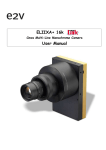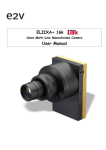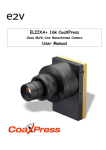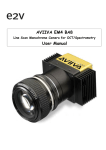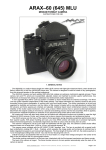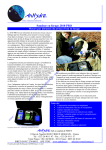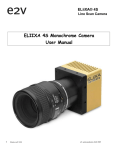Download ELIIXA+ 16k Pixels User Manual
Transcript
ELIIXA+ 16k Pixels Cmos Multi-Line Monochrome Camera User Manual ELIIXA+® 16k Pixels Cmos Multi-Line Camera Summary 1 CAMERA OVERVIEW............................................................................. 4 1.1 1.2 1.3 1.4 2 CAMERA PERFORMANCES....................................................................... 6 2.1 2.2 2.3 2.4 2.4.1 2.4.2 3 3.2.1 3.2.2 Quantum Efficiency ....................................................................................................................................................8 Spectral Response.......................................................................................................................................................8 Mechanical Drawings.............................................................................................................................. 9 Input/output Connectors and LED (Camera Link)......................................................................... 10 Power Connector (Camera Link)............................................................................................................................... 11 Status LED Behaviour............................................................................................................................................... 11 GETTING STARTED ........................................................................... 13 4.1 4.2 5 Camera Characterization ...................................................................................................................... 6 Image Sensor........................................................................................................................................... 7 Multi-Lines modes................................................................................................................................... 7 Response & QE curves ........................................................................................................................... 8 CAMERA HARDWARE INTERFACE ............................................................. 9 3.1 3.2 4 Features.................................................................................................................................................... 4 Key Specifications.................................................................................................................................. 4 Description ............................................................................................................................................... 5 Typical Applications ............................................................................................................................... 5 Out of the box ........................................................................................................................................... 13 Setting up in the system ............................................................................................................................ 13 CAMERA SOFTWARE INTERFACE ........................................................... 14 5.1 5.2 5.2.1 5.2.2 5.2.3 5.3 Control and Interface ......................................................................................................................... 14 Serial Protocol and Command Format .............................................................................................. 15 Syntax .........................................................................................................................................................................15 Command Processing .................................................................................................................................................15 GenICam ready ..........................................................................................................................................................15 Camera Commands ................................................................................................................................ 16 5.3.1 Information ................................................................................................................................................................16 5.3.2 Image Format ............................................................................................................................................................19 5.3.3 Acquisition Control ................................................................................................................................................... 24 5.3.4 Gain and Offset ........................................................................................................................................................ 28 5.3.5 Flat Field Correction................................................................................................................................................ 30 5.3.5.1 Activation and Auto-Adjust ...................................................................................................................... 32 5.3.5.2 Automatic Calibration ................................................................................................................................ 33 5.3.5.3 Manual Flat Field Correction..................................................................................................................... 34 5.3.5.4 FFC User Bank Management...................................................................................................................... 35 5.3.6 Look Up Table ........................................................................................................................................................... 37 2 REVA–UM ELIIXA+ 16k 02/12 e2v semiconductors SAS 2012 ELIIXA+® 16k Pixels Cmos Multi-Line Camera 5.3.7 5.3.8 5.3.9 6 APPENDIX A: Test Patterns .................................................................. 42 6.1 6.2 Test Pattern 1: Vertical wave ............................................................................................................ 42 Test Pattern 2: Fixed Horizontal Ramps ........................................................................................ 42 6.2.1 6.2.2 7 In 8 bits format ....................................................................................................................................................... 42 In 12 bits format...................................................................................................................................................... 43 APPENDIX B: Thermal Management .......................................................... 44 7.1 8 Heat Sink ................................................................................................................................................ 44 APPENDIX C: Data Cables .................................................................... 44 8.1 9 CameraLink ............................................................................................................................................. 44 APPENDIX D: Lenses Compatibility........................................................... 45 10 APPENDIX E: TROUBLESHOOTING....................................................... 46 10.1 10.2 11 3 Statistics and Line Profile ...................................................................................................................................... 39 Privilege Level ........................................................................................................................................................... 40 Save & Restore Settings ..........................................................................................................................................41 Camera..................................................................................................................................................... 46 CommCam Connection........................................................................................................................... 46 APPENDIX F: Revision History ............................................................. 47 REVA–UM ELIIXA+ 16k 02/12 e2v semiconductors SAS 2012 ELIIXA+® 16k Pixels Cmos Multi-Line Camera 1 CAMERA OVERVIEW 1.1 Features 1.2 Cmos Sensor 4x 16384 Pixels, 5 x 5µm Multi-Line structure (1, 2 or 4 lines to adapt the sensitivity) Interface : o Medium/Full CameraLink®, 85MHz per Channel Line Rate : o Up to 40000 l/s In CameraLink® Data Rate : o Up to 680 MB/s In CameraLink® Bit Depth : 8 or 12bits Flat Field Correction Look Up Table Low Power Consumption : <13W Compliant with Standard Lenses of the Market Key Specifications Note : All values in LSB is given in 12 bits format Characteristics Typical Value Unit Sensor Characteristics at Maximum Pixel Rate Resolution 4 x 16384 pixel size (square) 5x5 Max line rate – CameraLink Full 8 x 85MHz 40 Max line rate – CameraLink Medium 4 x 85MHz 20 Pixels µm kHz Radiometric Performance at Maximum Pixel Rate and minimum camera gain Bit depth Response (broadband) Full Well Capacity 4 8, 12 Bits 450 LSB/(nJ/cm²) 30000 (in 2S mode) electrons Response non linearity 1 % PRNU 3 % Dynamic range (1 line) 69 dB Dynamic range (2 lines) 72 dB REVA–UM ELIIXA+ 16k 02/12 e2v semiconductors SAS 2012 ELIIXA+® 16k Pixels Cmos Multi-Line Camera Functionality (Programmable via Control Interface) Analog Gain Offset Trigger Mode Up to 12 (x4) -4096 to +4096 dB LSB Timed (Free run) and triggered (Ext Trig, Ext ITC) modes Mechanical and Electrical Interface Size (w x h x l) Weight Lens Mount 100 x 156 x 36 mm tdb g M95 x 1 - Sensor alignment ( see chapter 4 ) ±100 µm Sensor flatness ±35 µm Power supply Power dissipation - CameraLink Single 12 DC to 24 DC V < 13 W 0 to 55 (front face) or 70 (Internal) °C -40 to 70 °C General Features Operating temperature Storage temperature Regulatory 1.3 CE, FCC and RoHS compliant Description e2v’s next generation of line scan cameras are setting new, high standards for line rate and image quality. Thanks to e2v’s recently developed multi line CMOS technology, the camera provides an unmatched 100 000 lines/s in a 16k pixel format and combines high response with an extremely low noise level; this delivers high signal to noise ratio even when short integration times are required or when illumination is limited. The 5µm pixel size is arranged in four active lines, ensuring optimal spatial resolution in both scanning and sensor directions with off-the-shelf lenses. This Camera opens up an array of new possibilities for the next generation of inspection systems for demanding applications such as flat panel display, PCB and solar cell inspection. 1.4 Typical Applications 5 Flat Panel Display Inspection PCB Inspection Solar Cell Inspection Glass Inspection Print Inspection REVA–UM ELIIXA+ 16k 02/12 e2v semiconductors SAS 2012 ELIIXA+® 16k Pixels Cmos Multi-Line Camera 2 CAMERA PERFORMANCES 2.1 Camera Characterization Unit Mode 1S (0dB) Min Typ. Max Mode 2S (0dB) Min Typ. Mode 4S (0dB) Max Min Max Tbd - Dark Noise RMS LSB - Tbd Tbd Dynamic Range - - Tbd - - Tbd - - Tbd - SNR dB - Tbd - - Tbd - - Tbd - Non Linearity (between 10% and 90%) Tbd Typ. Tbd % Tbd Tbd Without Flat Field Correction – Half saturation Tbd Tbd - Tbd - - Tbd Tbd - Tbd - % - Tbd Tbd - Tbd - - Tbd - % - Tbd Tbd - Tbd - - Tbd - FPN rms LSB FPN peak-peak LSB PRNU hf PRNU peak-peak - Tbd - Tbd With Flat Field Correction PRNU hf LSB - Tbd Tbd - Tbd - - Tbd - PRNU peak-peak LSB - Tbd - - Tbd - - Tbd - Test conditions : Figures in LSB are for a 12bits format. Measured at exposure time = 100µs and line period = 100µs in Ext Trig Mode (Max Exposure Time) Maximum data rate Light source 3200K with BG38 filter 2 mm thickness Stabilized temperature 30/40/55 °C (Room/Front Face/Internal) SNR Calculated at 75% Vsat with minimum Gain. 6 REVA–UM ELIIXA+ 16k 02/12 e2v semiconductors SAS 2012 ELIIXA+® 16k Pixels Cmos Multi-Line Camera 2.2 Image Sensor The Eliixa+ 16k sensor is composed of two pairs of sensitive lines. Each pair of lines use the same Analog to Digital Column converter (ADC Column). An appropriate (embedded) Time delay in the exposure between each line this allows to combine two successive exposures in order to double the sensitivity of a single line. 2.3 ADC Column Intermediate Blind Pixel Pixel Line A Pixel Line B This Time Delay Exposure is used only in the 4S multi-line modes (4 Lines) as described below. Pixel Line C The 16384 Pixels of the whole sensor are divided in 4 blocks of 4096 pixels. Intermediate Blind Pixel Pixel Line D ADC Column Multi-Lines modes Multi-Lines Modes (16k Pixels Output) Mode 1S = B Mode 2S = B+C (FPGA) Mode 4S = (A.B)+(C.D) Note : (A.B) = summation in the sensor 7 REVA–UM ELIIXA+ 16k 02/12 a b c d a b c d a b c d B B C A B C D e2v semiconductors SAS 2012 ELIIXA+® 16k Pixels 2.4 Response & QE curves 2.4.1 Quantum Efficiency ELIIXA+ 16k Quantum Efficiency 60.00% 50.00% QE(%) 40.00% 30.00% 20.00% 10.00% 0.00% 350 450 550 650 750 850 950 (nm) 2.4.2 Spectral Response ELIIXA+ 16k Response (minimum gain, 4S mode) 600 LSB 12bits/(nj/cm2) 500 400 300 200 100 0 350 450 550 650 750 850 950 (nm) 8 REVA–UM ELIIXA+ 16k 02/12 e2v semiconductors SAS 2012 ELIIXA+® 16k Pixels 3 CAMERA HARDWARE INTERFACE 3.1 Mechanical Drawings Z X 9 REVA–UM ELIIXA+ 16k 02/12 Y e2v semiconductors SAS 2012 ELIIXA+® 16k Pixels Sensor alignment Z = -9.4 mm X = 9 mm Y = 50mm Flatness Rotation (X,Y plan) Tilt (versus lens mounting plane) 3.2 ±100µm ±100 µm ±100 µm ±25 µm ±0,2° 0,05° Input/output Connectors and LED (Camera Link) USB Connector For Firmware upgrade Power Connector : 12-24V DC Multi-Colored LED for Status and diagnostic CameraLink Connector CL2 CameraLink Connector CL1 10 REVA–UM ELIIXA+ 16k 02/12 e2v semiconductors SAS 2012 ELIIXA+® 16k Pixels 3.2.1 Power Connector (Camera Link) Camera connector type: Hirose HR10A-7R-6PB (male) Cable connector type: Hirose HR10A-7P-6S (female) Pin Signal Pin PWR PWR PWR 1 2 3 GND GND GND 4 5 6 Power supply from 12 to 24v Power 13W max with an typical inrush current peak of 1,8A during power up Camera side description Typical values Signal Current consumption ELIIXA+ CL (normal) ELIIXA+ CL (Standby) 12V 1,06A 0,47A Power up Time : Around 43s (Green Light) 24V 0,54A 0,25A 2 Inrush current (A) 1.5 1 0.5 0 0.041 0.042 0.043 0.044 tim e (s) 3.2.2 Status LED Behaviour After less than 2 seconds of power establishment, the LED first lights up in ORANGE. Then after a Maximum of 30 seconds, the LED must turn in a following colour : Colour and state Green and continuous Green and blinking slowly Red and continuous 11 REVA–UM ELIIXA+ 16k 02/12 Meaning OK Waiting for Ext Trig (Trig1 and/or Trig2) Camera out of order : Internal firmware error e2v semiconductors SAS 2012 3.3 CameraLink Output Configuration Medium CameraLink Mode 4 Channels 8bits 4 Channels 12bits Full CameraLink Mode 8 Channels 8bits 4 ELIIXA+® 16k Pixels Connector CL1 + CL2 Pixels per Channel 4 x 85MHz 4 x 85MHz 4 x 4096 4 x 4096 8 x 85MHz 8 x 2096 STANDARD CONFORMITY The AVIIVA EM2/EM4 cameras have been tested using the following equipment: • A shielded power supply cable • A Camera Link data transfer cable ref. 14B26-SZLB-500-OLC (3M) e2v recommends using the same configuration to ensure the compliance with the following standards. 4.1 CE Conformity The AVIIVA EM2/EM4 cameras comply with the requirements of the EMC (European) directive 2004/108/CE (EN50081-2, EN 61000-6-2). 4.2 FCC Conformity The AVIIVA EM2/EM4 cameras further comply with Part 15 of the FCC rules, which states that: Operation is subject to the following two conditions: • This device may not cause harmful interference, and • This device must accept any interference received, including interference that may cause undesired operation This equipment has been tested and found to comply with the limits for Class A digital device, pursuant to part 15 of the FCC rules. These limits are designed to provide reasonable protection against harmful interference when the equipment is operated in a commercial environment. This equipment generates, uses and can radiate radio frequency energy and, if not installed and used in accordance with the instruction manual, may cause harmful interference to radio communications. Operation of this equipment in a residential area is likely to cause harmful interference in which case the user will be required to correct the interference at his own expense. Warning: Changes or modifications to this unit not expressly approved by the party responsible for compliance could void the user's authority to operate this equipment. 4.3 RoHs Conformity AVIIVA EM2/EM4 cameras comply with the requirements of the RoHS directive 2002/95/EC. 12 REVA–UM ELIIXA+ 16k 02/12 e2v semiconductors SAS 2012 ELIIXA+® 16k Pixels 4 GETTING STARTED 4.1 Out of the box The contains of the Camera box is the following : - One Camera ELIIXA+ Power connector (Hirose HR10A-7P-6S -female) There is no CDROM delivered with the Camera : This User Manual , but also the Pleora PureGeV Package, DemoGeV and all documentation associated to the GigE Vision, GenICam standards can be downloaded from the web site : This ensure you to have an up-to-date version. Main Camera page : www.e2v.com/cameras On the appropriate Camera Page (ELIIXA+) you’ll find a download link first version of CommCam compliant is indicated in the last Chapter Login : commcam Password : chartreuse 4.2 Setting up in the system w CCD Plan f Focal Plan L s FOV w FOV = f L The Compliant Lenses and their accessories are detailed in Appendix C 13 REVA–UM ELIIXA+ 16k 02/12 e2v semiconductors SAS 2012 ELIIXA+® 16k Pixels 5 CAMERA SOFTWARE INTERFACE 5.1 Control and Interface As all the e2v Cameras, the ELIIXA+ CL is delivered with the friendly interface control software COMMCAM.UCL (as “Ultimate Camera Link”) which is based on the GenICam standard COMMCAM recognizes and detects automatically all the UCL Cameras connected on any transport layers (Camera Link or COM ports) of your system. Once connected to the Camera you have an easy access to all its features. The visibility of these features can be associated to three types of users: Beginner, Expert or Guru. Then you can make life easy for simple users. Minimum version of CommCam is 2.1.0 in order to recognize the ELIIXA+ Camera. 14 REVA–UM ELIIXA+ 16k 02/12 e2v semiconductors SAS 2012 ELIIXA+® 16k Pixels 5.2 Serial Protocol and Command Format The Camera Link interface provides two LVDS signal pairs for communication between the camera and the frame grabber. This is an asynchronous serial communication based on RS-232 protocol. The serial line configuration is: Full duplex/without handshaking 9600 bauds (default), 8-bit data, no parity bit, 1 stop bit. The baud rate can be set up to 115200 5.2.1 Syntax Internal camera configurations are activated by write or readout commands. The command syntax for write operation is: w <command_name> <command_parameters><CR> The command syntax for readout operation is: r <command_name><CR> 5.2.2 Command Processing Each command received by the camera is processed: The setting is implemented (if valid) The camera returns “>”<return code><CR> The camera return code has to be received before sending a new command. The camera return code has to be received before sending a new command. Some commands are longer than the others : Waiting for the return code ensure a good treatment of all the commands Without saturating the buffer of the camera Table 5-1. Camera Returned Code Returned code meaning >3 (or “>OK”) : All right, the command will be implemented Error Bad CRC (for write command only) >16 Invalid Command ID (Command not recognize or doesn't exist) >33 >34 Invalid Access (the receipt of the last command has failed). Parameter out of range (the parameter of the last command send is out of range). >35 Access Failure (bad communication between two internal devices). >0 5.2.3 GenICam ready The CameraLink Standard is not yet compliant with GenICam Standard, but as much as possible, each command of the ELIIXA+ will have its correspondence with the Standard Feature Naming Convention of the GenIcam Standard. This correspondence is given in parenthesis for each feature/command as the following example : • Vendor name (DeviceVendorName) : “e2v” 15 REVA–UM ELIIXA+ 16k 02/12 e2v semiconductors SAS 2012 ELIIXA+® 16k Pixels 5.3 Camera Commands 5.3.1 Information These values allow to indentify the Camera. They can be accessed in CommCam software in the “Info” section • 16 All these values are fixed in factory and can’t be changed (shaded) except the Camera User ID which can be fixed by the Customer : Vendor name (DeviceVendorName) : “e2v” Read function : “r vdnm”; Returned by the camera : “e2v”, string of 32 bytes (including “/0”) Can not be written • Model Name (DeviceModelName) : Internal name for GenICam : Read function : “r mdnm”; Returned by the camera : String of 32 bytes (including “/0”) : Can not be written • Device Manufacturer Info (DeviceManufacturerInfo) : Get Camera ID Read function : “r idnb”; Returned by the camera : String of 128 bytes (including “/0”) Can not be written • Device Version (DeviceVersion) : Get Camera Hardware version Read function : “r dhwv”; Returned by the camera : String of 32 bytes (including “/0”) Can not be written • Device Firmware Version (DeviceFirmwareVersion): Get camera synthetic firmware Read function : “r dfwv”; Returned by the camera : String of 16 bytes (including “/0”) Can not be written REVA–UM ELIIXA+ 16k 02/12 e2v semiconductors SAS 2012 ELIIXA+® 16k Pixels 17 • Device SFNC Version : 1.5.0 These Parameters (Major, Minor, Sub Minor) are only virtual ones in order to give the SFNC compliance of the Camera. • Device ID (DeviceID) : Camera Factory identifier ID Read function : “r cust”; Returned by the camera : String of 128 bytes (including “/0”) Write function : “w cust <idstr>” • Device User ID (DeviceUserID) : Camera user identifier ID Read function : “r cust”; Returned by the camera : String of 128 bytes (including “/0”) Write function : “w cust <idstr>” • Electronic board ID (ElectronicBoardID) : Get PcB Board ID Read function : “r boid”; Returned by the camera : String of 32 bytes (including “/0”) Can not be written • Device Temperature Selector (DeviceTemperatureSelector) : MainBoard Can not be written • Device Temperature (DeviceTemperature) : Get Main Board Temperature Read function : “r temp”; Return by the camera : Temperature in Q10.2 format (8 bits signed + 2 bits below comma). Value is between -512 to 511 in °C. • Device Serial Port Selection : Indicates the Serial Port on which the Camera is connected. • Device Serial Port Baud Rate (ComBaudRate): Set the Camera BaudRate Read function : “r baud”; Returned by the camera : Value of the Baud Rate Write function : “w baud” <index> with the index as follows : 1 : 9600 Bauds (default value at power up) 2 : 19200Bauds 6 : 57600Bauds 12 : 115200Bauds REVA–UM ELIIXA+ 16k 02/12 e2v semiconductors SAS 2012 ELIIXA+® 16k Pixels • Standby Mode (Standby) : Activation of the Standby mode of the Camera Read function : “r stby”; Returned by the camera : Boolean. 0 : Disable Standby mode (False) 1 : Enable stanby mode (True) Write function : “w stby <val>”; <val> is 0 or 1. Internal Temperature A standby mode, what for ? °C 75 Standby Off 70 65 60 55 50 45 40 Standby On 35 30 13 0 14 0 11 0 12 0 90 10 0 80 60 70 50 40 30 10 20 5 7 25 0 The Standby mode stops all activity on the sensor level. The power dissipation drops down to about 6W. During the standby mode, the Camera carry on sending black images through the CameraLink outputs in order to avoid any disruption in the application system. Once the Standby mode turned off, the Camera recover in less than 1ms to send images again from the sensor. Time (mn) • Camera status : Get the Camera status register (32bits Integer) Read function : “r stat”; Returned by the camera : 32bits integer : 18 Bit 0 : (StatusWaitForTrigger) : True if no trig received from more than 1sec Bit 1 : (StatusTriggerTooFast) : Missing triggers. Trig signal too fast Bit 2 : (StatusSensorConnection) : True is the Sensor pattern is checked as failed. Bit 3, 4, 5, 6, 7 : Reserved Bit 8 : (StatusWarningOverflow) : True is an overflow occurs during FFC or Tap balance processing. Bit 9 : (StatusWarningUnderflow) : True is an underflow occurs during FFC or Tap balance processing Bits 10 : Reserved Bits 11 : Scrolling Direction : 0 = Reverse, 1 ) Forward. Updated only by external CC3 (CameraLink) Bits, 12, 13, 14, 15 : Reserved Bit 16 : (StatusErrorHardware) : True if hardware error detected Bits 17 to 31 : Reserved REVA–UM ELIIXA+ 16k 02/12 e2v semiconductors SAS 2012 ELIIXA+® 16k Pixels 5.3.2 Image Format 19 • Sensor Width (SensorWidth) : Get the physical width of the Sensor. This value is available in the CommCam “Image Format Control” section : Read function : “r snsw”; Return by the sensor : Integer 16384. Can not be written; • Sensor Height (SensorHeight) : Get the physical height of the Sensor. This value is available in the CommCam “Image Format Control” section : No Access. Virtual command in xml”; Value always = 1 • Width Max (WidthMax) : Get the Maximum Width of the Sensor. This value is available in the CommCam “Image Format Control” section : No Access. The value is mapped on “SensorWidth” • Height Max (HeigthMax) : Get the Maximum height of the Sensor. This value is available in the CommCam “Image Format Control” section : No Access. Virtual command in xml”; Value always = 1 • Output mode (OutputMode) : Set the CameraLink Output mode (refer also to Chap 3. : CameraLink Output Configuration). This command is available in the CommCam “Image Format Control” section : REVA–UM ELIIXA+ 16k 02/12 e2v semiconductors SAS 2012 ELIIXA+® 16k Pixels Read function : “r mode”; Returned by the camera : Output mode from 0 to 2 (see table below). Write function : “w mode” <value> : detailed in the table below : Modes Medium 4 Outputs 8bits Medium 4 Outputs 12bits Full 8 Outputs 8bits Connector CL1 4 x 85MHz 8 bits 4 x 85MHz 12 bits 8 x 85MHz 8 bits Mode value 0 1 2 Structure of the Camera Link Channels for interfacing Medium Mode 4x4096 Pixels at 85MHz each Channel 4 Taps Separate, from Left to Right Ch 1 Ch 2 Ch 3 Ch 4 FULL Mode 8x2048 Pixels at 85MHz each Channel 8 Taps Separate, from Left to Right Ch 1 Ch 2 Ch 3 Ch 4 Ch 5 Ch 6 Ch 7 Ch 8 • 20 Output Frequency (OutputFrequency) : Get the CameraLink Data Output Frequency. This value is available in the CommCam “Image Format Control” section : Read function : “r clfq”; Return by the Camera : 0 (Frequency = 85MHz) Can not be written; REVA–UM ELIIXA+ 16k 02/12 e2v semiconductors SAS 2012 ELIIXA+® 16k Pixels • Sensor Mode (SensorMode) : Defines the number of Line used on the Sensor. This command is available in the CommCam “Image Format Control” section : Structure of the Sensor FPGA Web Direction ADC In 2S Mode, the summation of the two lines is done in the FPGA : B+C In 4S Mode, the summation of the two double lines is done in the FPGA : (AB )+ (BC) Intermediate Blind Pixel Pixel Line A Exposure delays 1S Pixel Line B 2S 4S Pixel Line C Pixel Line D Intermediate Blind Pixel ADC Read function : “r smod”; Returned by the camera : Integer from 0 to 2 Write function : “w smod” <value> : “0” : “1S” mode or Single Line. Only one line (Line B) of the sensor is outputted. “1” : “2S” mode or Dual Lines. The two centred Lines B & C of the sensor are outputted. The Summation is done in the FPGA “2” : “4S” mode or Four Lines. All the lines of the sensor are outputted. A & B and B & C summation is done in the sensor. The overall summation is done in the FPGA As the « 4S » mode is performing an internal Time delay exposure on the lines A & B and C & D, the variation of the Exposure time is not possible in this mode. Then the only Two trigger modes available are “Free Run or External Triggered with Maximum Exposure time”. Then the parameters “Sensor Mode” and “Synchronization Mode” are linked : If “4S” Sensor mode is selected, only the two synchro modes detailed above are available in the Synchronization mode Menu. In the Same Way, if any of the other Synchronization modes is selected (“Free Run” for example), then the “4S” mode is not available in the Sensor Mode Menu. 21 REVA–UM ELIIXA+ 16k 02/12 e2v semiconductors SAS 2012 ELIIXA+® 16k Pixels • Multi-Line Gain (MultiLineGain) : Enables the MultiLine Gain of x0,5 . This value is available in the CommCam “Image Format Control” section : Read function : “r mlig”; Return by the sensor : “0” if disabled (Gain x1 by default); “1” if Gain x0,5 activated. Write Function : “w mlig <value>” “0” : Default Gain x1 is active. “1” : Gain x0,5 is enabled (only when the 2S mode of the sensor is enabled) Why Using a Multi-Line Gain of x0,5 ? Web Direction When the Light source is enough to use the “1S” mode of the Sensor (one single line), the best is to use 2 lines (“2S” mode) and then to divide the result by two by using the Multi-Line Gain set at “x0,5” : In this case, the Full Well capacity is multiplied by x2 (two output registers are used) but the readout noise is only multiplied by √2 then the SNR is improved by a factor of 2/√2. Pixel Line A Exposure delays 1S Pixel Line B 2S Pixel Line C Pixel Line D Intermediate Blind Pixel ADC • Reverse Reading (X) (ReverseReading) : Allows to output the line in the Reverse-X direction. This value is available in the CommCam “Image Format Control” section : Read function : “r revr”; Return by the Camera : 0 or 1 (enabled/disabled) Write function : “w revr <value>”; “0” : Disabled. “1” : Enables the reverse reading out (see below for “normal” direction) • Scan Direction (ScanDirection) : Set the scan direction for the sensor. This value is available in the CommCam “Image Format Control” section : Read function : “r scdi”; Return by the Camera : 0, 1 or 2 (Forward/reverse/external) 22 Intermediate Blind Pixel Write function : “w scdi <value>”; REVA–UM ELIIXA+ 16k 02/12 e2v semiconductors SAS 2012 ELIIXA+® 16k Pixels “0” : Forward. “1” : Reverse “2” : Externally controlled (by CC3 of the CameraLink Sync signals) The Forward direction is defined as detailed beside : Forward/reverse information has to be set correctly as soon as the Mode “2S” or “4S” of the sensor is set : In these tow modes, the sensor/Camera need to know what is the real order of the lines for the exposure delays. This information can be set dynamically by using the CC3 Trig signal of the CameraLink connector (change the direction “on the fly”). In these case, the Trigger signification is : “0” : Forward. “1” : Reverse This positioning takes also in account that the mode “Reverse X” is “Off” (Normal readout direction) • Test Image Selector (TestImageSelector) : Defines if the data comes from the Sensor or the FPGA (test Pattern). This command is available in the CommCam “Image Format” section : Read function : “r srce”; Returned by the camera : “0” if Source from the Sensor and “1 to 5” if test pattern active Write function : “w srce” <value> : “0” : To switch to CCD sensor image “1” : Grey Horizontal Ramp (Fixed) : See AppendixA “2” : White Pattern (Uniform white image : 255 in 8Bits or 4095 in 12bits) “3” : Grey Pattern (Uniform middle Grey : 128 in 8bits or 2048 in 12 bits) “4” : Black Pattern (Uniform black : 0 in both 8 and 12 bits) “5” : Grey vertical Ramp (moving) The test pattern is generated in the FPGA : It’s used to point out any interface problem with the Frame Grabber. When any of the Test pattern is enabled, the whole processing chain of the FPGA is disabled. 23 REVA–UM ELIIXA+ 16k 02/12 e2v semiconductors SAS 2012 ELIIXA+® 16k Pixels 5.3.3 Acquisition Control This section deals with all the Exposure, Line period and synchronisation modes • Synchronisation Mode (TriggerPreset) : Timed or Triggered, it defines how the grabbing is synchronized. This command is available in the CommCam “Acquisition Control” section : Read function : “r sync”; Returned by the camera : • “0” : Internal Line Trigger with Exposure time Internally Controlled (Free Run). Not available when Sensor mode is set in “4S” • “1” : External Trigger with Exposure Time Internally Controlled. Not available when Sensor mode is set in “4S” • “2” : External Trigger with maximum Exposure time • “3” : One External with Exposure Time Externally Controlled. The same Trigger signal defines the line period and its low level defines the exposure time. Not available when Sensor mode is set in “4S” • “4” : Two External Triggers with Exposure Time Externally Controlled : CC2 defines the start of the exposure (and also the start Line) and CC1 defines the Stop of the exposure. Not available when Sensor mode is set in “4S” • “5” : Internal Line Trigger with maximum Exposure Time Write function : “w sync” <value> 24 REVA–UM ELIIXA+ 16k 02/12 e2v semiconductors SAS 2012 ELIIXA+® 16k Pixels Synchronization Modes with Variable Exposure Time Td Synchro Mode Th Tper Line Trigger Sync = 0 Sync = 1 CC1 or Internal Tint Exposure Time Programmed (Exposure Time) Exposure Time Programmed Tht ITC Trigger Sync = 3 CC1 Line Triggers CC1 Sync = 4 CC2 Tintreal Exposure Time Internal In the Camera / sensor Tpix 2 Label Min Unit Th 120 nsec Tht Tpix µsec Td tbd nsec Tpix Digital Conversion No Exposure start before this point Tpix : Timing Pixel. During this uncompressible period, the pixel and its black reference are read out to the Digital converter. During the first half of this timing pixel (read out of the black reference), we can consider that the exposure is still active. Digital Conversion : During the conversion, the analog Gain is applied by the gradient of the counting ramp (see next chapter : Gain & Offset). The conversion time depends on the pixel format : - 8 or 10 bits : 6µs - 12 bits : 24µs This conversion is done in masked time, eventually during the next exposure period. Td : Delay between the Start exposure required and the real start of the exposure. If Tper is the Line Period (internal or external coming from the Trigger line), in order to respect this line Period, the Exposure Time as to be set by respecting : Tint + Tpix <= Tper Then, the real exposure time is : Tintreal = Tint + Tpix/2 - Td. In the same way, The high level period of the Trig signal in sync=3 mode, Tht > Tpix 25 REVA–UM ELIIXA+ 16k 02/12 e2v semiconductors SAS 2012 ELIIXA+® 16k Pixels Synchronisation Modes with Maximum Exposure Time Td Synchro Mode Th Line Trigger Sync = 2 Sync = 5 CC1 or Internal Tper = Tint Tintreal Exposure Time Internal Label Min Unit Th 120 nsec Td - nsec Tpix Tpix 2 2 Tpix In the Camera / sensor Tpix Digital Conversion Digital Conversion In these modes, the rising edge of the Trigger (internal or External) starts the readout process (Tpix) of the previous integration. The Real exposure time (Tintreal) is finally equal to the Line Period (Tper ) even if it’s delayed from Tpix/2 + Td from the rising edge of the incoming Line Trigger. • Exposure time (ExposureTime): Defines the exposure time when set in the Camera. This command is available in the CommCam “Acquisition Control” section : Read function : “r tint”; Returned by the camera : Integer from 10 to 65535 (=1µs to 6553,5µs by step o 100ns) Write function : “w tint” <value> ; 26 This value of exposure time is taken in account only when the synchronisation mode is “free run” (0) or “Ext Trig with Exposure time set” (1). Otherwise it’s ignored. Due to the limitation of the timing pixel inside the sensor, the Exposure time has to be set by taking in account the following limitation : REVA–UM ELIIXA+ 16k 02/12 e2v semiconductors SAS 2012 ELIIXA+® 16k Pixels For a Line Period of LinePer, the maximum exposure time possible without reduction of line rate is : Tintmax = Tper-Tpix (Tpix is defined above) but the effective Exposure Time will be about Tintreal = Tint + Tpix/2. • Line Period (LinePeriod) : Defines the Line Period of the Camera in Timed mode. This command is available in the CommCam “Acquisition Control” section : Read function : “r tper”; Returned by the camera : Integer from 1 to 65536 (=0,1µs to 6553,6µs by step o 100ns) Write function : “w tper” <value> ; The line period is active only in Free Run modes. It’s also disabled if in this mode, the Integration time is set higher than the Line Period. The real effective minimum Line Period value accepted by the camera is indicated below : Minimum Line Period Medium modes (4 Taps) : 50µs Full Mode (8 Taps) : 25µs 27 REVA–UM ELIIXA+ 16k 02/12 e2v semiconductors SAS 2012 ELIIXA+® 16k Pixels 5.3.4 Gain and Offset Sensor FPGA Pixel Preamp Gain Amp Gain X X FFC Offset Gain + X FFC Adjust X LUT or Contrast Exp. Offset Gain + OUT X Action on whole line Action per pixel Analog Gain in the ADC The only analog Gain available in the ELIIXA+ is located at the sensor level, in the ADC converter. 10 bits conversion x4 1024 x2 This “Preamp Gain” is in fact a variation of the ramp of the comparator of the ADC. Then 3 Values are available : x1, x2 and x4 LSB x1 512 8 bits conversion 255 Clamp (Black Ref) Setting • Comparator Ramps at different Gains Value issued from the Pixel Preamp Gain : (GainAbs with GainSelector= AnalogAll) Set the Pre-amplification Gain. This command is available in the CommCam “Gain & Offset” section. Read function : “r pamp”; Returned by the camera : Integer corresponding to one of the 3 different step values : • 0 : x1 (0dB) • 1 : x2 (6dB) • 2 : x4 (12dB) Write function : “w pamp” <int> ; 28 REVA–UM ELIIXA+ 16k 02/12 e2v semiconductors SAS 2012 ELIIXA+® 16k Pixels • Gain: (GainAbs with GainSelector= GainAll) Set the Amplification Gain. This command is available in the CommCam “Gain & Offset” section : Read function : “r gain”; Returned by the camera : Value from 0 to 6193 corresponding to a Gain range of 0dB to +8dB calculated as following : Gain(dB) = 20.log(1+ Gain/4096). Write function : “w gain” <int> ; • Digital Gain (GainAbs with GainSelector=DigitalAll) : Set the global Digital Gain. This command is available in the CommCam “Gain & Offset” section : Read function : “r gdig”; Returned by the camera : Integer value from 0 to 255. The corresponding Gain is calculated as 20log(1+val/64) in dB Write function : “w gdig” <int> ; • Digital Offset (BlackLevelRaw with BlackLevelSelector=All) : Set the global Digital Offset. This command is available in the CommCam “Gain & Offset” section : Read function : “r offs”; Returned by the camera : Value from –4096 to +4095 in LSB Write function : “w offs” <int> ; The Contrast Expansion (both Digital Gain & Offset) will be automatically disabled if the LUT is enabled.. 29 REVA–UM ELIIXA+ 16k 02/12 e2v semiconductors SAS 2012 ELIIXA+® 16k Pixels 5.3.5 Flat Field Correction How is performed the Flat Field Correction ? What is the Flat Field correction (FFC) ? The Flat Field Correction is a digital correction on each pixel which allows : To correct the Pixel PRNU (Pixel Response Non Uniformity) and DSNU (Dark Signal Non Uniformity) To Correct the shading due to the lens To correct the Light source non uniformity Before After How is calculated / Applied the FFC ? The FFC is a digital correction on the pixel level for both Gain and Offset. Each Pixel is corrected with : o An Offset on 8 bits (Signed Int 5.3). They cover a dynamic of ±16LSB in 12bits with a resolution of 1/8 LSB 12bits. o A Gain on 14 bits (Unsigned Int 14) with a max gain value of x3 o The calculation of the new pixel value is : P’ = ( P + Off).(1 + Gain/8192) The FFC processing can be completed with an automatic adjustment to a global target. This function is designed as “FFC Adjust”. This adjustment to a User target is done by an internal hidden gain which is recalculated each time the FFC is processed while the FFC adjust function is enabled. The FFC is always processed with the max pixel value of the line as reference. If enabled, the FFC adjust module (located at the output of the FFC module) calculates the adjustment gain to reach the target defined by the User. When the FFC result is saved in memory, the adjust gain and target are saved in the same time in order to associate this gain value with the FFC result. 30 REVA–UM ELIIXA+ 16k 02/12 e2v semiconductors SAS 2012 ELIIXA+® 16k Pixels User Target value Adjustment gain 3020 Standard FFC computed on the max of the line Pi xels How to perform the Flat Field Correction ? FPN/DSNU Calibration Cover the lens Launch the FPN Calibration : Grab and calculation is performed in few seconds PRNU Calibration The User must propose a white/gray uniform target to the Camera (not a fixed paper). The Gain/Light conditions must give a non saturated image in any Line. The Camera must be set in the final conditions of Light/ Gain and in the final position in the System. I f required, set a user target for the FFC adjust and enable it. White uniform (moving) target Launch the FFC Enable the FFC You can save the FFC result (both FPN+PRNU in the same time) in one of the 4 x FFC User Banks. The user target and Gain are saved with the associated FFC in the same memory. Advices The ELIIXA+ Cameras have 4 x FFC Banks to save 4 x different FFC calibrations. You can use this feature if your system needs some different conditions of lightning and/or Gain because of the inspection of different objects : You can perform one FFC per condition of Gain/setting of the Camera ( 4 Max) and recall one of the four global settings (Camera Configuration + FFC + Line Balance) when required. 31 REVA–UM ELIIXA+ 16k 02/12 e2v semiconductors SAS 2012 ELIIXA+® 16k Pixels 5.3.5.1 • Activation and Auto-Adjust FFC Activation (FFCEnable) : Enable/disable the Flat Field Correction. This command is available in the CommCam “Flat Field Correction” section : Read function : “r ffcp” : Returns the FFC Status (0 if disabled, 1 if enabled) Write function : “w ffcp 1” : Enable the FFC. “w ffcp 0” : Disabled the FFC • FFC Adjust Function : This Feature is available in the CommCam “Flat Field Correction/ Automatic Calibration” section : o Gains adjust (FFCAdjust): Enable/Disable the function Read function : “r ffad”. Returns the status of the function (0 if disabled) Write function : “w ffad 0” : Disable the FFC Adjust function. “w ffad 1” : Enable the FFC Adjust function. o Auto Adjust Target Level (FFCAutoTargetLevel): set the value for the User Target. Read function : “r tfad”. Returns the Target value (from 0 to 4095) Write function : “w tfad <value>” : Set the Target Value (in 12bits) FFC Adjust : A good usage. When there are several Cameras to set up in a system on a single line, the most difficult is to have a uniform lightning whole along the line. If each Camera performs its own Flat field correction, relative to the max of each pixel line, the result will be a succession of Camera lines at different levels. => The FFC Adjust function allows to set the same target value for all the Cameras in the system and then to get a perfect uniform line whole along the system with a precision of 1 LSB to the Target. The reasonable value for the User Target is not more than around 20% of the max value of the line. 32 REVA–UM ELIIXA+ 16k 02/12 e2v semiconductors SAS 2012 ELIIXA+® 16k Pixels 5.3.5.2 Automatic Calibration • FPN/DSNU Calibration : o o FPN Calibration Control (FPNCalibrationCtrl) : Launch or abort of the FPN process for the Offsets calculation. These commands are available in the CommCam “Flat Field Correction / Automatic Calibration ” section : Read function : “r calo” : Returns the FPN Calculation Process Status (0 if finished, 1 if processing) Write function : “w calo 1” : Launch the FPN Calibration Process. “w calo 0” : Abort the FPN Calibration Process. FPN Coefficient Reset (FPNReset) : Reset the FPN (Offsets) coefficient in Memory. This command is available in the CommCam “Flat Field Correction / Manual Calibration ” section : Write function : “w rsto 0” : Reset (set to 0) the FPN coefficients in memory. This doesn’t affect the FFC User Memory Bank but only the active coefficients in Memory. • PRNU Calibration : o PRNU Calibration Control (FFCCalibrationCtrl) : Launch or abort of the PRNU process for the Gains calculation. This command is available in the CommCam “Flat Field Correction / Automatic Calibration ” section : Read function : “r calg” : Returns the PRNU Calculation Process Status (0 if finished, 1 if processing) Write function : “w calg 1” : Launch the PRNU Calibration Process. “w calg 0” : Abort the PRNU Calibration Process. o 33 PRNU coefficient Reset (PRNUReset) : Reset the PRNU (Gains) coefficient in Memory. This command is available in the CommCam “Flat Field Correction / Manual Calibration ” section : REVA–UM ELIIXA+ 16k 02/12 e2v semiconductors SAS 2012 ELIIXA+® 16k Pixels Write function : “w rstg 0” : Reset (set to 0) the FPN coefficients in memory. This doesn’t affect the FFC User Memory Bank but only the active coefficients in Memory. Some Warnings can be issued from the PRNU/FPN Calibration Process as “pixel Overflow” of “Pixel Underflow” because some pixels have been detected as too high or too low in the source image to be corrected efficiently. The Calculation result will be proposed anyway as it’s just a warning message. The Status Register is the changed and displayed in CommCam “Status” section : Register status is detailed chap §6.3.3. 5.3.5.3 Manual Flat Field Correction The FFC Coefficients can also be processed outside of the Camera or changed manually by accessing directly their values in the Camera : This is the “Manual” FFC. In CommCam, the User can access to a specific interface by clicking on “click for extended control” in both “Manual FFC calibration” and “Manual FPN calibration sections” : This will allow the user to upload/download out/in the Camera the FFC coefficients in/from a binary or text file that can be processed externally. It is recommended to setup the baud rate at the maximum value possible (115000 for example) otherwise the transfer can take a long time. 34 REVA–UM ELIIXA+ 16k 02/12 e2v semiconductors SAS 2012 ELIIXA+® 16k Pixels • FPN coefficients modification : Direct access to the FPN coefficients for reading or writing. The FPN coefficients are read packets of x128 coefficients : Read function : “r ffco <addr>” : Read 128 consecutive FPN user coefficients starting from <addr> address. Returned value is in hexadecimal, without space between values (one unsigned short per coefficient). Write function :” w ffco <addr><val> : Write 128 consecutive FPN user coefficients starting from the <addr> address. <val> is the concatenation of individual FPN values, without space between the values (one unsigned short per coefficient). • PRNU coefficients modification : Direct access to the PRNU coefficients for reading or writing. The PRNU coefficients are read packets of x128 coefficients : Read function : “r ffcg <addr>” : Read 128 consecutive PRNU user coefficients starting from <addr> address. Returned value is in hexadecimal, without space between values (one unsigned short per coefficient). Write function :” w ffcg <addr><val> : Write 128 consecutive PRNU user coefficients starting from the <addr> address. <val> is the concatenation of individual PRNU values, without space between the values (one unsigned short per coefficient). 5.3.5.4 FFC User Bank Management The new-processed FFC values can be saved or restored in/from 4 x User banks. Both Gains and Offsets in the same time but also the FFC Adjust User target and associated gain. These functions are available in the Flat Field correction/Save & Restore FFC section : Restore FFC from Bank (RestoreFFCFromBank) : Restore the FFC from a Bank in the current FFC. Read function : “r rffc” : Get the current FFC Bank used Returned by the camera : 0 for Factory bank or 1 to 4 for User banks Write function : “w rffc <val>” : Bank <val> 1 to 4 for User banks Note : Factory means neutral FFC (no correction). 35 Save FFC in User Bank (SaveFFCToBank) : Save current FFC in User Bank Can not de read Write function : “w sffc <val>” : User bank <val> if from 1 to 4. REVA–UM ELIIXA+ 16k 02/12 e2v semiconductors SAS 2012 ELIIXA+® 16k Pixels FFC User Bank Usage At the power up : - Last User Bank used is loaded in RAM User Save User1 User2 Load Ram Memory User3 User4 Reset FPN 36 REVA–UM ELIIXA+ 16k 02/12 Reset a User bank : - Reset the RAM (FPN/PRNU individually) - Save in the bank to reset Reset PRNU e2v semiconductors SAS 2012 ELIIXA+® 16k Pixels 5.3.6 Look Up Table The User can define an upload a LUT in the Camera that can be used at the end of the processing. The LUT is defined as a correspondence between each of the 4096 gray levels (in 12 bits) with another outputted value. For example, a “negative” or “reverse” LUT is the following equivalence : Real value Output value 0 4095 1 4094 2 4093 … Then the size of each value is 12bits but the exchanges with the Application/PC are done on 16 bits : For 4096 gray levels (from 0 to 4095) the total file size for a LUT is 8Ko. If this LUT is enables, the “Contrast Expansion” feature (digital Gain and Offset) will be disabled LUT Enable (LUTEnable) : Enable the LUT and sizable the Digital Gain / Offset This function is available in the LUT section :. Read function : “r lute” : Get the LUT status Returned by the camera : 0 is LUT disabled, 1 if enabled Write function : “w lute <val>” : <val> is 0 for disable, 1 for enable • Upload / Download the LUT coefficients : Direct access to the LUT coefficients for reading or writing. In CommCam, the User can access to a specific interface by clicking on “click for extended control” in the LUT section : Read function : “r lutc <addr>” : Read 128 LUT coefficients starting from address <addr> from 0 to 4095-128. Returned value is the concatenation in hexadecimal of individual LUT values, without space between values. (one unsigned short per coefficient) 37 REVA–UM ELIIXA+ 16k 02/12 e2v semiconductors SAS 2012 ELIIXA+® 16k Pixels Write function :” w lutc <addr><val> : Write 128 LUT coefficients starting from address <addr> form 0 to 4095-128. <val> is the concatenation in hexadecimal of individual LUT values, without space between values. (one unsigned short per coefficient) • Save & Restore LUT in User Banks : The LUT loaded in RAM memory can be saved or restored in/from 4 User banks. These functions are available in the LUT/Save & Restore LUT Settings section : o Restore LUT from Bank (RestoreLUTFromBank) : Restore the LUT from a User Bank in the current RAM Memory. Read function : “r rlut” : Get the current LUT Bank used Returned by the camera : 1 to 4 for User banks Write function : “w rlut <val>” : Bank <val> 1 to 4 for User banks o Save LUT in User Bank (SaveLUTToBank) : Save current LUT in User Bank Can not de read Write function : “w slut <val>” : User bank <val> if from 1 to 4. The bank number <val> is given in (LUTSetSelector) 38 REVA–UM ELIIXA+ 16k 02/12 e2v semiconductors SAS 2012 ELIIXA+® 16k Pixels 5.3.7 Statistics and Line Profile This function allows the User to get some statistics on a pre-defined ROI. On request, the Camera acquires and then calculates some key values as the min, the max, the average or the standard deviation in this Region of Interest. The grab and calculation command and also the collection of the results is not performed in real time as it is done through the serial connection. This function and the results are available in CommCam in the “Line Profile Average” Section : Line Profile average measurement (LineAverageProfile) : Control the grab and computation of the statistics. Read function : “r pixs” : Get the status of the calculation Returned by the camera : 0 : finished, 1: running Write function : “w rffc 1” : Start the accumulation and then the computing “w rffc 0” : Abort the computing. The Calculated values are detailed as following : o Pixel average Value (PixelROIMean) : Average gray level value calculated on whole Region of interest Read function : “r pavr” : Get the average value Returned by the camera : Unsigned format value : U12.4 o Pixel Standard deviation (PixelROIStandardDeviation) : standard deviation of all the pixel gray level values of Region of interest Read function : “r pstd” : Get the standard deviation Returned by the camera : Unsigned format value : U12.4 o Pixel Min value (PixelROIMin) : Minimum gray level pixel value on the whole region of interest. Read function : “r pmin” : Get the Minimum value Returned by the camera : Unsigned format value : U12.4 o Pixel Max Value (PixelROIMax) : Maximum gray level pixel value on the whole region of interest Read function : “r pmax” : Get the maximum value Returned by the camera : Unsigned format value : U12.4 39 REVA–UM ELIIXA+ 16k 02/12 e2v semiconductors SAS 2012 ELIIXA+® 16k Pixels Pixel access Line number (PixelAccessLineNumer) : Set the number of lines to accumulate. Read function : “r pixl” : Get the number of line Returned by the camera : 1, 256, 512 or 1024 Write function : “w pixl <val>” : Set the number of lines. <val> is 1, 256, 512 or 1024. Pixel ROI Start (PixelRoiStart) : Set the Region of Interest start position. Read function : “r prod” : Get the starting pixel Returned by the camera : value between 0 and 16383 Write function : “w prod <val>” : Set the starting pixel. <val> is between 0 and 16383 . Pixel ROI Width (PixelRoiWidth) : Set the Width of the Region of Interest. Read function : “r prow” : Get the width in pixel Returned by the camera : value between 1 and 16384 Write function : “w prow <val>” : Set the ROI width in pixels. <val> is between 1 and 16384 After performing a line profime measurement, all the values computed which are described below are not refreshed automatically in CommCam : You have to right-click on each value and ask for an individual refresh. 5.3.8 Privilege Level There are 3 privilege levels for the camera : Factory (0) : Reserved for the Factory Integrator (1) : Reserved for system integrators User (2) : For all Users. The Cameras are delivered in Integrator mode. They can be locked in User mode and a specific password is required to switch back the Camera in Integrator mode. This password can be generated with a specific tool available from the hotline ([email protected]) This function is available in the Privilege section : 40 Privilege level Management (PrivilegeLevel) : Get the current Camera privilege level.. Read function : “r lock” : Get the current privilege Returned by the camera : 0 to 2 Write function : “w lock <val>” : <val> is as follow 2 : Lock the Camera in Integrator or “privilege User” <computed value> : Unlock the Camera back in Integrator mode REVA–UM ELIIXA+ 16k 02/12 e2v semiconductors SAS 2012 ELIIXA+® 16k Pixels 5.3.9 Save & Restore Settings The settings (or Main configuration) of the Camera can be saved in 4 different User banks and one Integrator bank. This setting includes also the FFC and LUT enable This function is available in the Save & Restore Settings section : • Load settings from Bank : Allows to restore the Camera settings. Read function : “r rcfg” : Get the current Tap Bank in use Write function : “w rcfg <val>” : Load settings from bank <val> (0: Factory , 1 to 4 for Users, 5 for Integrator) Save settings to Bank : Allows to save the Camera settings in User or Integrator Bank Write function : “w scfg <val>” : Save the current settings in the User bank <val> (1 to 4 for User, 5 for Integrator) The integrator bank (User Set5) can be written only if the Camera is set in integrator mode (Privilege level = 1). This integrator bank can be used as a « Factory default » by a system integrator. 41 REVA–UM ELIIXA+ 16k 02/12 e2v semiconductors SAS 2012 ELIIXA+® 16k Pixels 6 APPENDIX A: Test Patterns 6.1 Test Pattern 1: Vertical wave The Test pattern 1 is a vertical moving wave : each new line will increment of 1 gray level in regards with the previous one. In 12 bits the level reaches 4095 before switching down to 0 In 8 bits the level reaches 255 before switching down to 0 6.2 Test Pattern 2: Fixed Horizontal Ramps 6.2.1 In 8 bits format 250 200 150 100 50 0 0 2048 4096 6144 8192 10240 12288 14336 19 18 An increment of 1 LSB is made every 16 pixels When it reaches 255, turns back to 0 and starts again 17 16 15 14 250 42 260 REVA–UM ELIIXA+ 16k 02/12 270 280 290 e2v semiconductors SAS 2012 ELIIXA+® 16k Pixels 6.2.2 In 12 bits format 4096 3072 2048 1024 0 0 2048 4096 6144 8192 10240 12288 14336 300 295 An increment of 1 LSB is made for each pixel. When it reaches 4095, turns back to 0 and starts again 290 285 280 275 270 265 260 255 250 250 43 260 REVA–UM ELIIXA+ 16k 02/12 270 280 290 e2v semiconductors SAS 2012 ELIIXA+® 16k Pixels 7 APPENDIX B: Thermal Management 7.1 Heat Sink The ELIIXA+ is not delivered with an additional : The design of the housing and the low power consumption of the Sensor made it not necessary. 8 APPENDIX C: Data Cables 8.1 CameraLink You may check the compliance of your CameraLink cables with the transportation of the 85MHz data rate : Depending on cable quality, the usual limitation is about 5m long. Some brands claims for a compliance at up to 10m with such a data rate but it has to be certified. The usual problem encountered with a cable issue is a “snow” around some gray levels (as for a mismatch configuration between 8/10/12 bits). This may also be visible and pointed out by switching the camera on the fixed Test pattern. 44 REVA–UM ELIIXA+ 16k 02/12 e2v semiconductors SAS 2012 ELIIXA+® 16k Pixels 9 APPENDIX D: Lenses Compatibility QIOPTICS (LINOS) Inspec.x. L 5.6/105 Nominal Magnification 0,33 X Magnification Range 0,25 – 0,45 X M95 Focus tube Reference 2408-012-000-41 Lens Reference Part number 0703-085-000-20 Inspec.x. L 5.6/105 0,5 X 0,4 – 0,65 X 2408-012-000-41 0703-084-000-20 Inspec.x. L 5.6/105 0,87 X 0,6 – 0,9 X 2408-012-000-43 0703-083-000-20 Inspec.x. L 5.6/105 1 X 0,85 – 1,2 X 2408-012-000-43 0703-082-000-20 Inspec.x. L 4/105 3 X 2,8 – 3,3 X 2408-012-000-46 0703-104-000-20 Inspec.x. L 4/105 3,5 X 3,3 – 3,7 X 2408-012-000-44 0703-095-000-21 Inspec.x. L 3.5/105 5 X 4,8 – 5,2 X 2408-012-000-45 0703-102-000-20 SCHNEIDER KREUZNACH SR 5.9/120-0058 Nominal Magnification 1 X Magnification Range 0,88 – 1,13 X SR 5.9/120-0059 0,75 X 0,63 – 0,88 X 252 mm 1002648 SR 5.9/120-0060 0,5 X 0,38 – 0,63 X 333 mm 1002650 SR 5.9/120-0061 0,33 X 0,26 – 0,38 X 453 mm 1004611 Accessories Working Distance nom. 212 Mag.) mm (at V mount 25mm macro-extension tube 20179 Necessary to combine the whole lens system V mount to Leica adapter Unifoc 76 Reference Part number 1002647 Adapter M58x0.75 – M95x1 20054 13048 1062891 Extension tube M95x1, 25mm Extension tube M95x1, 50mm Extension tube M95x1, 100mm To be combined to reach the appropriate magnification 1062892 1062893 1062894 EDMUND OPTICS Nominal Working Distance Reference TechSpec F4 1 X 151 mm NT68-222 TechSpec F4 1,33 X 158,5 mm NT68-223 TechSpec F4 2,0 X 129 mm NT68-224 TechSpec F4 3,0 X 110 mm NT68-225 Accessories Large Format Tip/Tilt Bolt Pattern Adapter, 2X NT69-235 Large Format Focusing Module NT69-240 Large Format Adapter Set NT69-241 NAVITAR Raptar Pro 4/86 45 REVA–UM ELIIXA+ 16k 02/12 1 X Extension Tubes on request 1 - 17494 e2v semiconductors SAS 2012 ELIIXA+® 16k Pixels 10 APPENDIX E: TROUBLESHOOTING 10.1 Camera Camera Power up 43s Red No LED If CommCam connection possible : then the LED is HS, else : Check power supply And its characteristics Contact Hotline Fixed Orange LED Color Fixed Green Blinking Green Camera waits for Trigger or Trigger too fast Camera ready Hardware failure or Firmware loading defect. Contact Hotline for RMA 10.2 CommCam Connection Refer to CommCam software Help for the connection issues. 46 REVA–UM ELIIXA+ 16k 02/12 e2v semiconductors SAS 2012 ELIIXA+® 16k Pixels 11 APPENDIX F: Revision History Manual Comments / Details Revision Rev A 47 First release REVA–UM ELIIXA+ 16k 02/12 Firmware version 1st CommCam compliant Version 1.0.19 2.1.0 e2v semiconductors SAS 2012 ELIIXA+® 16k Pixels How to reach us Home page: www.e2v.com Sales Office: Europe Regional sales office Americas e2v ltd e2v inc 106 Waterhouse Lane 520 White Plains Road Chelmsford Essex CM1 2QU Suite 450 Tarrytown, NY 10591 England USA Tel: +44 (0)1245 493493 Tel: +1 (914) 592 6050 or 1-800-342-5338, Fax: +44 (0)1245 492492 Fax: +1 (914) 592-5148 mailto: [email protected] mailto: [email protected] e2v sas 16 Burospace Asia Pacific e2v ltd F-91572 Bièvres Cedex 11/F., France Onfem Tower, Tel: +33 (0) 16019 5500 29 Wyndham Street, Fax: +33 (0) 16019 5529 Central, Hong Kong mailto: [email protected] Tel: +852 3679 364 8/9 Fax: +852 3583 1084 e2v gmbh mailto: [email protected] Industriestraße 29 82194 Gröbenzell Product Contact: Germany e2v Tel: +49 (0) 8142 41057-0 Avenue de Rochepleine Fax: +49 (0) 8142 284547 BP 123 - 38521 Saint-Egrève Cedex mailto: [email protected] France Tel: +33 (0)4 76 58 30 00 Hotline: mailto: [email protected] Whilst e2v has taken care to ensure the accuracy of the information contained herein it accepts no responsibility for the consequences of any use thereof and also reserves the right to change the specification of goods without notice. e2v accepts no liability beyond that set out in its standard conditions of sale in respect of infringement of third party patents arising from the use of tubes or other devices in accordance with information contained herein. 48 REVA–UM ELIIXA+ 16k 02/12 e2v semiconductors SAS 2012
















































